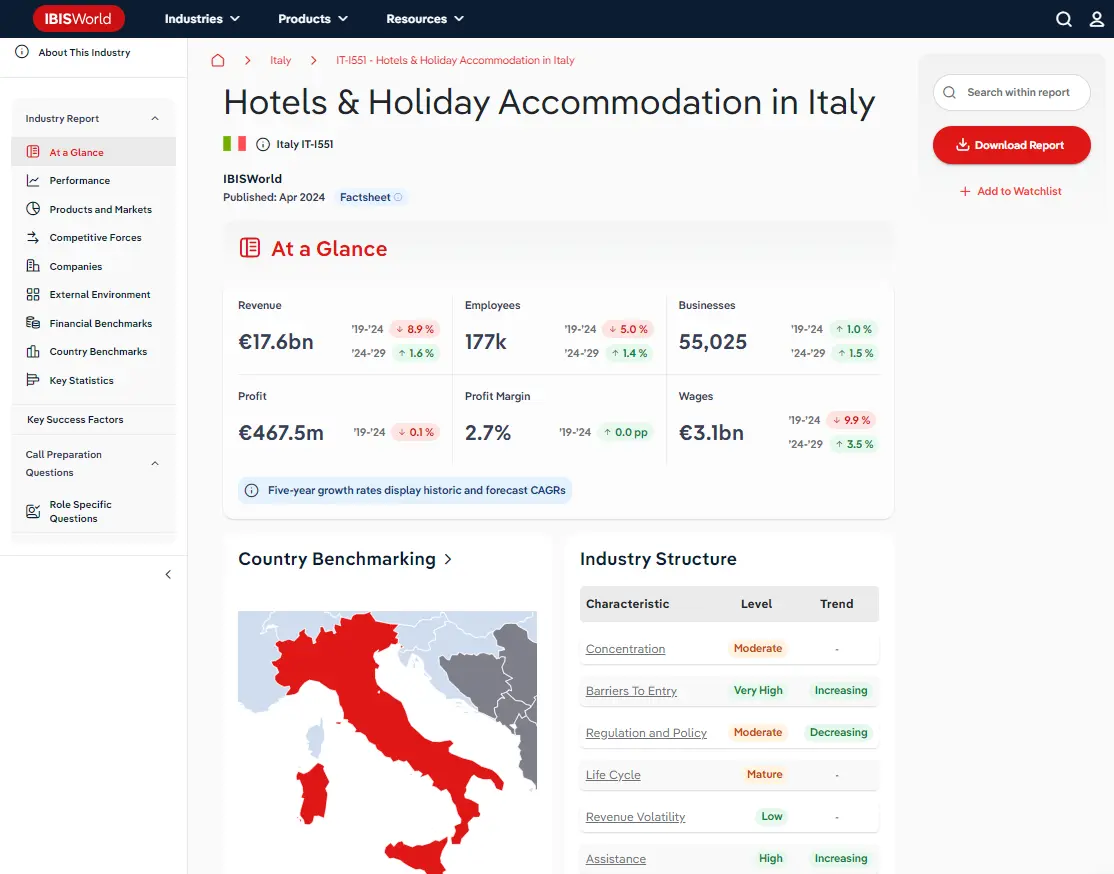Industry Statistics and Rankings
How does this industry perform in Serbia compared to Europe?
Country Benchmarking
Industry Data Serbia
Ranking are out of 37 European countries for which IBISWorld provides country-level factsheets.
Revenue
#19 In EuropeBusiness
#26 In EuropeEmployees
#19 In EuropeWages
#22 In EuropeThe Civil Engineering in Serbia ranks 19 in Europe with regards to its 2025 revenue (€7.6bn). Revenue received by operators in Serbia has been low in volatility over the past five-year period, with the average annual change in revenue (10.8 %) most comparable to...
Enterprises
Number of businesses in 2025
Revenue per Enterprise
Value (€ Million) in 2025
Top Questions Answered in this Report
Unlock comprehensive answers and precise data upon purchase. View purchase options.
What is the market size of the Civil Engineering industry in Serbia in 2025?
The market size of the Civil Engineering industry in Serbia is €7.6bn in 2025.
How many businesses are there in the Civil Engineering industry in Serbia in 2025?
There are 921 businesses in the Civil Engineering industry in Serbia, which has grown at a CAGR of 6.2 % between 2020 and 2025.
Has the Civil Engineering industry in Serbia grown or declined over the past 5 years?
The market size of the Civil Engineering industry in Serbia has been growing at a CAGR of 10.8 % between 2020 and 2025.
What is the forecast growth of the Civil Engineering industry in Serbia over the next 5 years?
Over the next five years, the Civil Engineering industry in Serbia is expected to grow.
What does the Civil Engineering industry in Serbia include?
Construction of road and Construction of railways are part of the Civil Engineering industry in Serbia.
How competitive is the Civil Engineering industry in Serbia?
The level of competition is high and steady in the Civil Engineering industry in Serbia.
Related Industries
This industry is covered in 37 countries
Domestic industries
Competitors
Complementors
Table of Contents
About this industry
Industry definition
The industry includes general construction for civil engineering projects. This includes new work, repair, addition and alterations on heavy structures such as roads, bridges, tunnels, railways, airfields, harbours, sewerage systems, industrial facilities, pipelines and electric lines, and outdoor sports facilities.
What's included in this industry?
Construction of road Construction of railwaysConstruction of bridgesConstruction of tunnelsConstruction of utility projectsIndustry Code
42 - Civil engineering in Serbia
Performance
Revenue Highlights
Trends
- Revenue
- 2025 Revenue Growth
- Revenue Volatility
Employment Highlights
Trends
- Employees
- Employees per Business
- Revenue per Employee
Business Highlights
Trends
- Businesses
- Employees per Business
- Revenue per Business
Current Performance
Charts
- Revenue in the Civil Engineering Industry in Serbia
- Employees in the Civil Engineering Industry in Serbia
- Business in the Civil Engineering Industry in Serbia
- Profit in the Civil Engineering Industry in Serbia
Current Performance
Analysis
How does this country's performance compare to Europe?
Life Cycle
Charts
- Industry Life Cycle Matrix
Products and Markets
Highlights
Trends
- Largest Market
- Product Innovation
International Trade
Heat maps
- Industry Concentration of Imports by Country
- Industry Concentration of Exports by Country
Competitive Forces
Highlights
Trends
- Concentration
- Competition
- Barriers to Entry
- Substitutes
- Buyer Power
- Supplier Power
ANALYSIS
What is the competitive landscape in Europe?
External Environment
Highlights
Trends
- Regulation & Policy
- Assistance
Key Takeaways
External Drivers
Analysis
What demographic and macroeconomic factors impact the Civil Engineering in Serbia industry?
Financial Benchmarks
Highlights
Trends
- Profit Margin
- Average Wage
- Largest Cost
Key Takeaways
Cost Structure
Charts
- Share of Economy vs. Investment Matrix
-
Industry Cost Structure Benchmarks:
- Marketing
- Depreciation
- Profit
- Purchases
- Wages
- Rent
- Utilities
- Other
Analysis
What trends impact cost in the Civil Engineering in Serbia industry?
Key Ratios
Data tables
- IVA/Revenue (2015-2030)
- Imports/Demand (2015-2030)
- Exports/Revenue (2015-2030)
- Revenue per Employee (2015-2030)
- Wages/Revenue (2015-2030)
- Employees per Establishment (2015-2030)
- Average Wage (2015-2030)
Country Benchmarks
European Leaders & Laggards
Data Tables
Top and bottom five countries listed for each:
- Revenue Growth (2025)
- Business Growth (2025)
- Job Growth (2025)
European Country Performance
Data Tables
Rankings available for 37 countries. Statistics ranked include:
- IVA/Revenue (2025)
- Imports/Demand (2025)
- Exports/Revenue (2025)
- Revenue per Employee (2025)
- Wages/Revenue (2025)
- Employees per Establishment (2025)
- Average Wage (2025)
Structural Comparison
Data Tables
Trends in 37 countries benchmarked against trends in Europe
- Concentration
- Competition
- Barriers to Entry
- Buyer Power
- Supplier Power
- Volatility
- Capital Intensity
- Innovation
- Life Cycle
Key Statistics
Industry Data
Data Tables
Including values and annual change:
- Revenue (2015-2030)
- IVA (2015-2030)
- Establishments (2015-2030)
- Enterprises (2015-2030)
- Employment (2015-2030)
- Exports (2015-2030)
- Imports (2015-2030)
- Wages (2015-2030)
Methodology
Where does IBISWorld source its data?
IBISWorld is a world-leading provider of business information, with reports on 5,000+ industries in Australia, New Zealand, North America, Europe and China. Our expert industry analysts start with official, verified and publicly available sources of data to build an accurate picture of each industry.
Each industry report incorporates data and research from government databases, industry-specific sources, industry contacts, and IBISWorld's proprietary database of statistics and analysis to provide balanced, independent and accurate insights.
IBISWorld prides itself on being a trusted, independent source of data, with over 50 years of experience building and maintaining rich datasets and forecasting tools.
To learn more about specific data sources used by IBISWorld's analysts globally, including how industry data forecasts are produced, visit our Help Center.

 France
France
 Italy
Italy
 Spain
Spain